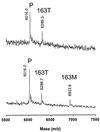Chip-based genotyping by mass spectrometry
- PMID: 10468554
- PMCID: PMC17834
- DOI: 10.1073/pnas.96.18.10016
Chip-based genotyping by mass spectrometry
Abstract
Silicon chips with immobilized target DNAs were used for accurate genotyping by mass spectrometry. Genomic DNAs were amplified with PCR, and the amplified products were covalently attached to chip wells via N-succinimidyl (4-iodoacetyl)aminobenzoate (SIAB) chemistry. Primer annealing, extension, and termination were performed on a 1-microl scale directly in the chip wells in parallel. Diagnostic products thus generated were detected in situ by using matrix-assisted laser desorption ionization mass spectrometry. This miniaturized method has the potential for accurate, high-throughput, low-cost identification of genetic variations.
Figures





References
-
- Collins F S, Patrinos A, Jordan E, Chakravarti A, Gesteland R, Walters L and the members of the Department of Energy and National Institutes of Health planning groups. Science. 1998;282:682–689. - PubMed
-
- Chee M, Yang R, Hubbell E, Berno A, Huang X C, Stern D, Winkler J, Lockhart D J, Morris M S, Fodor S P A. Science. 1996;274:610–614. - PubMed
-
- Kozal M J, Shah N, Shen N, Yang R, Fucini R, Merigan T C, Richman D D, Morris D, Hubbell E, Chee M, et al. Nat Med. 1996;2:753–759. - PubMed
-
- Hacia J G, Brody L C, Chee M, Fodor S P A, Collins F S. Nat Genet. 1996;14:441–447. - PubMed
-
- Wang D G, Fan J, Siao C, Berno A, Young P, Sapolsky R, Ghandour G, Perkins N, Winchester E, Spenser J, et al. Science. 1998;280:1077–1082. - PubMed
MeSH terms
Substances
LinkOut - more resources
Full Text Sources
Other Literature Sources

